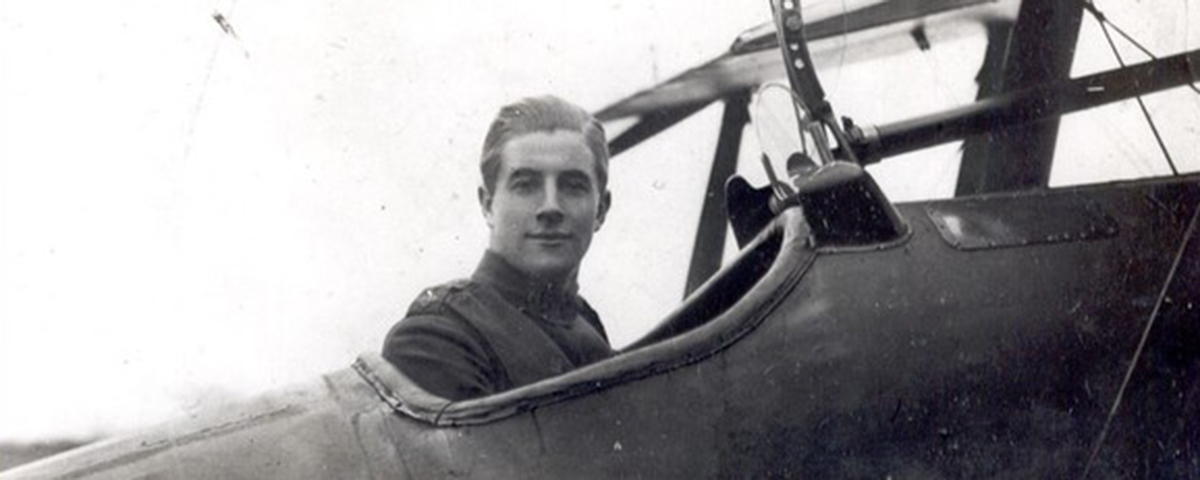“Shooting genius” James McCudden owed his success in aerial combat to precision, patience and perseverance.
At 14,000 feet, the air above Armentières, France, was thin and cold, but that didn’t bother British Captain James McCudden on September 19, 1917. His full attention was focused on a black spot below, a German Rumpler two-seater he was stalking. Never taking his eyes off his target, McCudden positioned his S.E.5a fighter with the sun behind him, then banked and plunged downward, pressing his firing button as the Rumpler filled his gunsight. Just one shot exploded from the barrel of his overwing Lewis machine gun—nothing more.
McCudden quickly switched to his fuselage-mounted Vickers, which spat out 30 rounds before it too jammed. Furious that his prey might escape, he was surprised to see the Rumpler’s propeller stop spinning and the plane begin trailing blue smoke. McCudden cleared his Lewis and sank 10 perfectly aimed shots into the enemy aircraft. He watched as the observer slumped and the Rumpler slowly spiraled down, crashing behind the German trenches.
It was classic McCudden: brilliant tactics, superb concentration, praiseworthy patience and extraordinary marksmanship. The 57- victory ace was one of the most influential, well-liked and respected officers in the Royal Flying Corps (later the Royal Air Force), ranking among the greatest flight commanders of World War I. Fortunately for posterity, McCudden’s recollections of war, full of typical British humor and understatement, have been preserved in his classic autobiography, Flying Fury: Five Years in the Royal Flying Corps.
James Thomas Byford McCudden was the son of an Irishman, born in Gillingham, Kent, on March 28, 1895, into a family with a long history of military service. He attended garrison school, excelling at shooting and sports. At 15 he joined the Royal Engineers, transferring to the RFC in 1913 as an air mechanic, following the lead of his elder brother William. One squadron commander recalled that James was “one of the best engine fitters we had, and was trusted implicitly.”
After war was declared in August 1914, McCudden embarked for France with No. 3 Squadron, which was equipped with French Morane-Saulnier L Parasols and assigned to reconnaissance, artillery spotting and bombing missions. He flew his first combat patrol as an observer, armed with a rifle, in November. McCudden was promoted to corporal and then sergeant in April 1915, just after he turned 20. A month later, he learned that his brother William had been killed in a flying accident. “This was a bad blow for me,” he wrote, “…and I felt his loss very keenly indeed.”
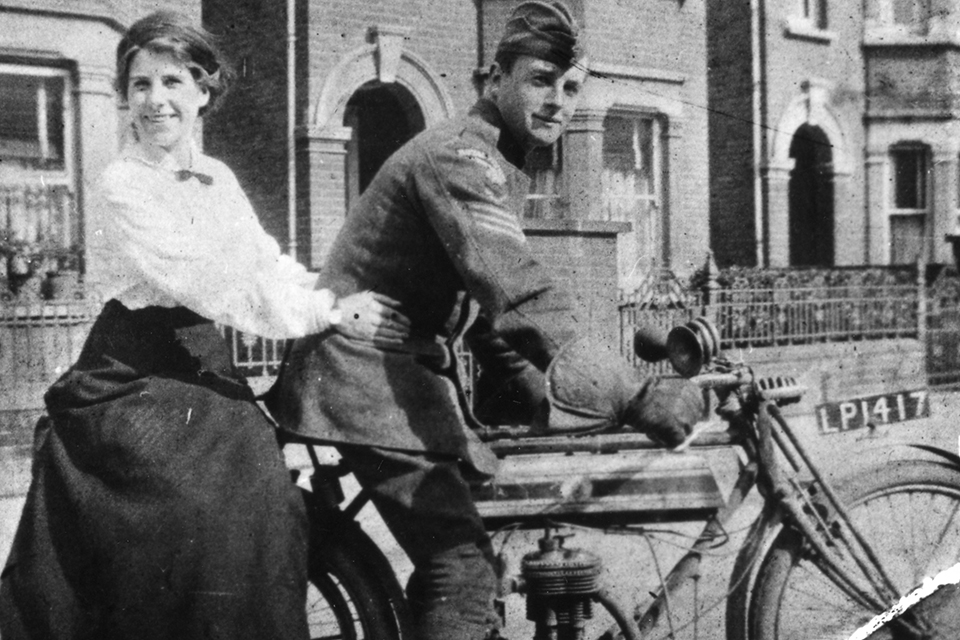
As ambitious as he was hard-working, McCudden applied for pilot training but was turned down. Apparently his superiors believed he was more valuable as a mechanic, though his working-class background may have also been a factor.
A revolutionary new German fighter was then dominating the skies, the Fokker E.I monoplane, equipped with a machine gun synchronized to fire through the propeller arc. In a letter to his mother, McCudden described one mission during which a Fokker “came over us like a flash, with the black crosses on his fuselage as plain as daylight. I managed to get off half a dozen rounds at him as he passed.” Later, while he was flying with his commanding officer, Major Edgar Ludlow-Hewitt, their plane was again attacked by a Fokker, possibly piloted by German ace Max Immelmann. Determined to drive off the German, McCudden stood up in the cockpit, firing his Lewis from his shoulder.
Impressed by McCudden’s moxie, the CO made him a full-time observer—resulting in some grumbling among squadron members. The RFC reflected the socially stratified Britain of its day: Many pilots were selected from public schools, such as Eton and Oxford, and were chosen for family connections rather than merit. The careers of working-class men like McCudden would herald immense changes that ultimately transformed both the British military and society as a whole.
After McCudden received the French Croix de Guerre in January 1916 for his success as an observer, his application to become a pilot was finally approved. Promoted to flight sergeant, he returned to England to train at Gosport, soloing after just four hours of dual instruction and receiving his pilot’s certificate in April. He was disappointed to learn that he would be remaining in Britain for a stint as a flying instructor.
In July he was assigned to No. 20 Squadron, flying two-seat F.E.2bs over the front. A month later he got his coveted fighter assignment with 29 Squadron, which was equipped with the Airco D.H.2, a rotary-powered pusher. This was “a very cold little machine,” McCudden remembered, “as the pilot had to sit in a small nacelle with the engine a long way back…no warmth from it at all.” During one patrol he recalled being “so intensely cold and miserable that I did not trouble to look around at all to see whether any Huns were behind me or not; in fact, I did not care whether I was shot down or not.”
McCudden flew escort for bombers, attacked observation balloons and hunted for Zeppelins. On September 6, he encountered a German two-seater over Houthem-Gheluwe, Belgium. Closing to 400 yards, “I opened fire,” he wrote.“I fired one drum of Lewis at him, and he continued to go down while I changed drums. I then got off another drum and still got no reply from the enemy gunner, but the German was going down more steeply now….” The victory, his “first Hun,” was confirmed the next day.
Later he had a dogfight with a Fokker that nearly cost him his life. Both pilots came head-on at each other, shooting. “I now did a silly thing,” McCudden recalled. “I put my engine off and dived, but not straight. The Fokker followed, shooting as opportunity offered, and I could hear his bullets coming far too close to be healthy.” The German managed to put just two rounds into McCudden’s aircraft, but the RFC pilot realized that if his opponent “had only been a little skillful I think he would have got me.”
These “little incidents,” as McCudden called them—bad shooting, near-fatal mistakes—“caused me to be very furious with myself.” Consequently he devoted much thought and training to the science of aerial warfare. He spent days testing and aligning his guns and perfecting his airplane. He became a skilled, careful flier.
With the Fokker now outclassed by Allied fighters such as the D.H.2 and the French Nieuport 11, the Germans countered in late August 1916 by introducing the Albatros D.I. Its sleek, streamlined fuselage, powerful inline Mercedes engine and two forward-mounted Spandau machine guns made it far superior to any Allied aircraft. McCudden vividly recalled his first dogfight with these formidable new opponents: “I heard a terrific clack, bang, crash, rip behind me, and found a Hun was firing from about ten yards in the rear, and his guns seemed to be firing in my very ears.” The RFC pilot escaped by doing a half-roll. He later counted 24 hits in his shredded plane. “It was not fun fighting an enemy who was 15 miles faster and had almost twice the climb,” he wrote. On December 27, McCudden had another tough fight with an Albatros, this time piloted by Lieutenant Manfred von Richthofen, who apparently claimed him as his 15th victim after McCudden spun down 9,200 feet to escape the legendary German ace.
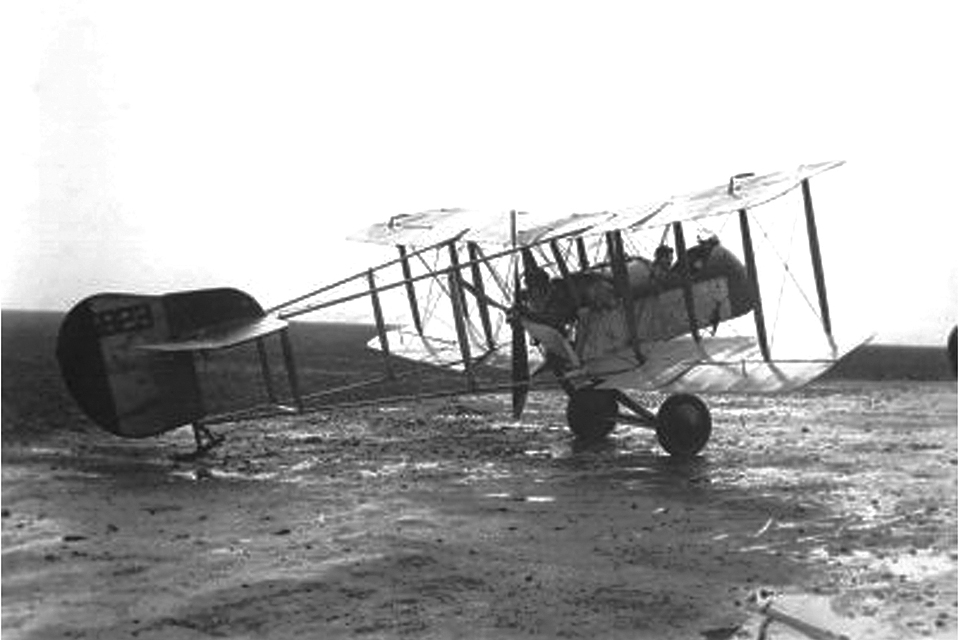
Despite his daily brushes with death, McCudden praised his opponents time and again—a rare example of gallantry in what had become a vicious, protracted war. “The German aviator,” he wrote, “is disciplined, resolute and brave, and is a foeman worthy of our best.” Despite that, he often described himself as “bloodthirsty” and clearly enjoyed the thrill of the chase, saying that those who fought badly “deserved to die.”
McCudden was commissioned a second lieutenant on January 1, 1917. After eight months in combat and 115 patrols, he was sent back to Britain at the end of February, now a five-victory ace. He was awarded the Military Cross and, by June, promoted to captain. Posted to the Joyce Green airfield as an instructor, he taught German tactics and went on a lecture tour to share his combat experience with novice pilots. One of his students was future ace Edward Mannock, with whom he became fast friends, linked by their Irish working-class roots and socialist politics. McCudden also trained his own impetuous younger brother, John Anthony.
Allotted a Sopwith Pup, McCudden had a Lewis machine gun installed on the top wing. He used the modified fighter to target the Gotha bombers and Zeppelins raiding England. Still, he yearned to return to the front.
Sent back to the war in July on a “refresher course,” McCudden flew Pups with No. 66 Squadron. During this period, he developed the tactic of flying on lone patrols at 15,000 feet or more, hunting the enemy. On July 21 he was invited to participate in a mission with the elite No. 56 Squadron, recently equipped with new S.E.5s. After engaging in a dogfight with German fighters and a two-seater—and bringing down one of the former—McCudden partied with the squadron’s officers.
A few weeks after returning to England, McCudden was informed that he would be sent back to France as a flight commander. “I was very pleased indeed,” he wrote, “as I knew, almost for a certainty, that I would go to No. 56 Squadron.”
McCudden joined 56 Squadron in mid-August, assigned to command B Flight, which included excellent pilots such as Lieutenants Reginald Hoidge and Arthur Rhys-Davids. The newcomer was allotted S.E.5a no. B519, the first of several of that type he would fly. Although early models of the Royal Aircraft Factory fighter had experienced engine, radiator and undercarriage troubles, McCudden wrote that he “liked the machine immensely” and considered it “far and away superior to the enemy” because of its top speed of 126 mph, “great strength, its diving and zooming powers, and its splendid view. Apart from this, it was a most warm, comfortable and easy machine to fly.”
On his first day with the squadron, McCudden skipped breakfast to align his guns and sights. “He must have fired the best part of a thousand rounds from each gun before he was satisfied,” recalled one mechanic. When McCudden came into the mess for lunch, some of his comrades booed him, mistaking his professionalism for showing off. Some looked down on his working-class roots and questioned why McCudden, with “only” five victories, had been made a flight commander while others were bypassed. “I’m afraid that at that time we just didn’t realize Mac’s worth,” explained A Flight commander Major Gerald Maxwell.
McCudden continually modified his S.E.5a to maximize its performance. He had a Sopwith Camel joystick installed, which he believed enabled him to fire his guns more accurately. He also shortened the exhaust pipes and later had a spinner—taken off an LVG C.V he downed— mounted to streamline the S.E.5a’s stub nose. This was painted red, so his men could identify him in the air. He flew no. B4891, marked with a “G” (later transposed to a “6”)—arguably one of the most famous British fighters of WWI—from December 1917 to March 1918, scoring 32 victories in it within three months. In 1918, eager to reach high-flying Rumplers, McCudden reduced his plane’s wing dihedral and had its engine fitted with high-compression pistons. There was a downside: Flying at 20,000 feet resulted in headaches, faintness and exhaustion.
On August 18, 1917, McCudden brought down an Albatros D.V that had rushed at him head-on, for his eighth kill. He bagged another the next day. On the evening of the 20th, he positioned himself 50 yards behind a D.V, firing bursts into it from both guns. The German fighter caught fire and went down. “That was my first Hun in flames,” he recalled. “As soon as I saw it I thought, ‘poor devil’ and really felt sick….” He scored a double that day.
On September 23, McCudden led B Flight into perhaps the most famous dogfight of the war, against German ace Lieutenant Werner Voss, flying a new Fokker F.I triplane. After a swirling battle in which Voss holed all seven of his opponents in roughly 10 minutes, RhysDavids shot him down. McCudden wrote, “As long as I live I shall never forget my admiration for [Voss]….his flying was wonderful, his courage magnificent….”About a month later Rhys-Davids was killed.
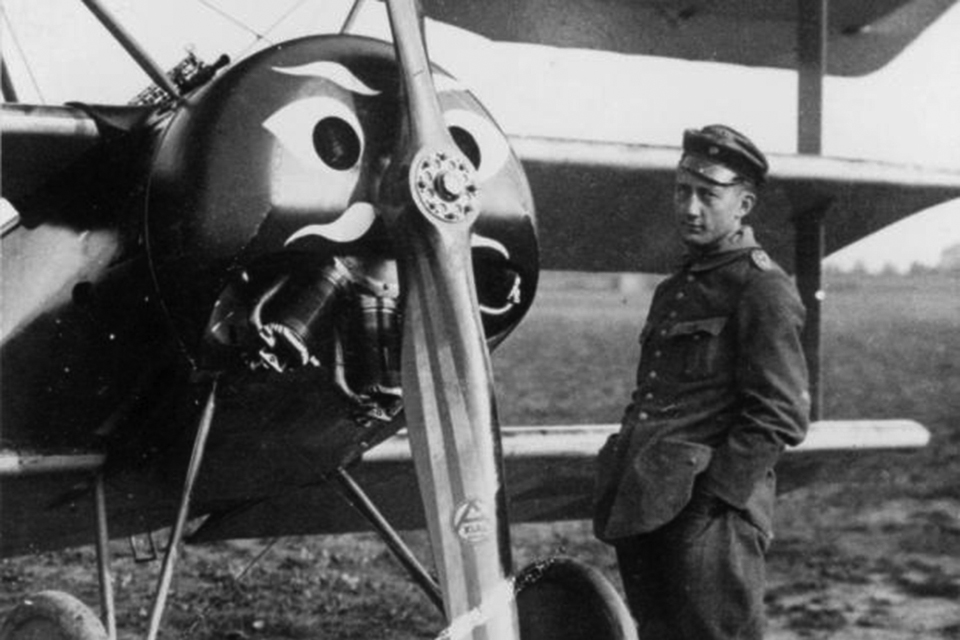
Sometimes the air war was characterized by bizarre contrasts. On September 27, McCudden brought down an LVG C.V in flames over the British lines. As the plane rolled over, he watched in horror as “the enemy gunner either jumped or fell out, and I saw him following the machine down, twirling round and round, all arms and legs, truly a ghastly sight.” The next morning McCudden shot the wings off a D.V, whose pilot also tumbled out and fell to his death. Moments later another Albatros outmaneuvered him, but he survived because the German suddenly broke off his pursuit. Soon after that McCudden was sedately breakfasting with his comrades before competing in the squadron ping-pong championship.
By this time McCudden’s score stood at 15. Described by engineering officer H. Charles as “a shooting genius,” the British ace had evolved into an expert hunter. He would stalk an enemy for up to two hours, waiting for the perfect moment to strike. “My system,” he explained, “was to always attack the Hun at his disadvantage if possible, and if I were attacked at my disadvantage I usually broke off the combat….I think that the correct way to wage war is to down as many as possible of the enemy at the least risk, expense and casualties to one’s own side.”
McCudden often targeted two-seaters, of greater strategic importance than fighters because of their vital role in photography, reconnaissance, bombing and artillery spotting. German two-seater crews were highly trained, and as the war progressed the planes had a double sting: machine guns mounted in the back and front. McCudden would allow them to fly deep into Allied territory, then dive and pull up underneath their tail sections, which blocked the observer’s field of fire. Many victims died in a sudden hail of bullets, not knowing what had hit them. He usually tried to kill the observer first, silencing his gun, then went after the pilot or engine. “I cannot describe the satisfaction,” he mused, “which one experiences after bringing a good stalk to a successful conclusion.”
In December McCudden scored 14 times. On the 23rd he destroyed four enemy aircraft in one day, a first for a British pilot. He was mentioned in the official communiqué, congratulatory telegrams poured in from senior officers and his comrades honored him with a celebratory dinner. On the 28th he shot the wings off a Rumpler at 16,000 feet and flamed another; pounced on an LVG at 9,000 feet, which exploded in flames; and shot up another LVG—all within 30 minutes. By early January 1918, McCudden had accounted for the squadron’s 250th and B Flight’s 100th victims. In the UK his picture appeared on the front page of the Daily Mail and other newspapers. He was sent on a tour, lecturing on his tactics and techniques. After another double victory on the 30th, his score reached 46.
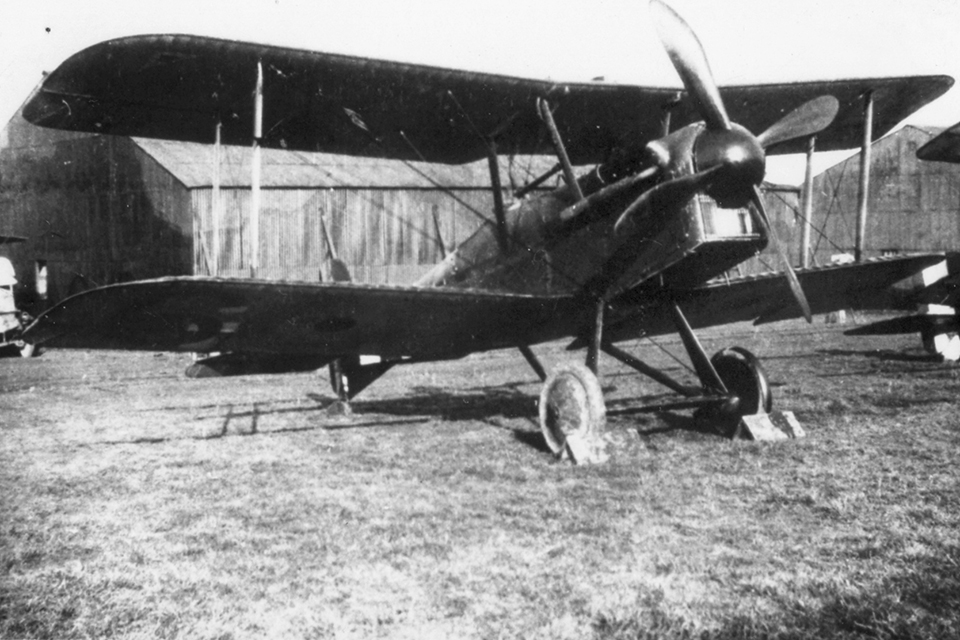
Just as he stalked the enemy, McCudden knew that death was always stalking him. He never forgot how, after one close-range engagement, his windscreen had been spattered with German blood. In late February 1918, he flew to his brother Anthony’s squadron to caution him about recklessly taking chances. Credited with eight victories, Anthony was killed just a month later.
As the war ground on, the faces of the dead likely haunted McCudden, who wrote of the dangers of becoming “too sentimental…one cannot afford to be so when one has to do one’s job of killing and going on killing.” C.G. Grey, editor of The Aeroplane, noted that McCudden “was a wonderfully deep thinker for his age,” perhaps missing the point that the grim realities of war had made him so. “I realized,” McCudden wrote,“that war is the most fiendish and cruel slaughter that it is possible to conceive.”
February was another immensely successful month for McCudden, with 11 enemy aircraft falling to his guns. One of these planes, a green tailed Albatros D.V that sported a “K” on its top wing, was flown by Corporal Julius Kaiser, who fell or jumped to his death after it burst into flames. A blue-tailed Albatros, McCudden’s second victim that day, soon followed, raising his score to 54. By the end of that month his tally stood at 57.
At the beginning of March, despite his protestations, McCudden was again sent home to serve as an instructor. “I cannot say how sorry I was to leave my Squadron,” he explained, “…that held many pleasant memories, and sad ones also.” His popularity had never been higher; indeed, McCudden was B Flight. Its total score stood at 123 against a mere four casualties, testimony to his outstanding leadership.
The squadron gave him a farewell dinner on March 2, and that night he wrote that he “regretted that I had to leave a life that was all and everything to me, and I confess I cried.” The next day he was entertained by generals and his comrades threw another party, presenting him with a silver model of an S.E.5a.
More honors awaited him in Britain, including the Victoria Cross, the UK’s highest award for bravery. Remarkably, he somehow found time to write his book, Flying Fury, despite a hectic schedule. In late June, promoted to major, he was delighted to learn that he had been appointed commander of No. 60 Squadron.
On the morning of July 9, McCudden bid farewell to his sister Mary in London. “I’d like you to look after these for me, sis,” he said, handing her a package that contained his decorations. Later that afternoon while he was taking off from Auxi-le-Château to join his new command, his S.E.5a stalled during a steep climbing turn, perhaps due to a faulty carburetor, and he crashed into a nearby wood. He was found unconscious near the wreck, suffering from head injuries. Rushed to a field hospital, 23-year-old James McCudden died that evening. He was buried at Wavans. It was an absurd death for such a perfectionist.
McCudden’s rich and varied career had spanned virtually the entire war. Along the way he lost two brothers and many friends. He had fought, and often conquered, Germany’s best men flying their finest machines. Number 56 Squadron’s Colonel Edward Galley remarked that “the perfect soldier had two qualities in equal proportions: discipline and initiative.…Jimmie McCudden was the nearest I have ever seen to that ideal.”
“It seems to me,” McCudden wrote, that “the very best fellows are always those who are killed….sometimes one sits and thinks, ‘Oh, this damned war and its cursed tragedies.’ After all, I suppose it is to be, and we cannot alter destiny.” When McCudden fell, Great Britain lost one of its very best.
O’Brien Browne writes from Heidelberg, Germany. For further reading, he suggests McCudden’s Flying Fury and also works by McCudden expert Alex Revell, including Victoria Cross: WWI Airmen and Their Aircraft; High in the Empty Blue: The History of 56 Squadron RFC/RAF 1916-1920; and James McCudden VC.
Originally published in the September 2011 issue of Aviation History. To subscribe, click here.

